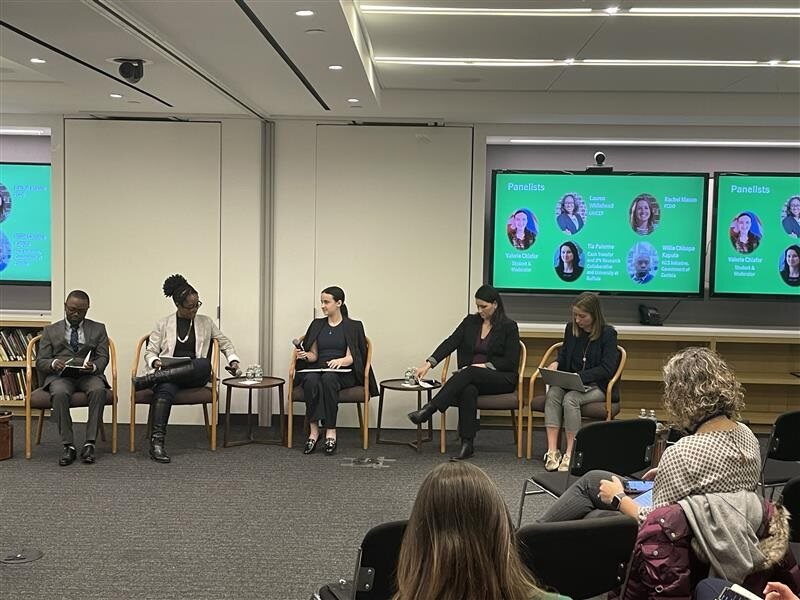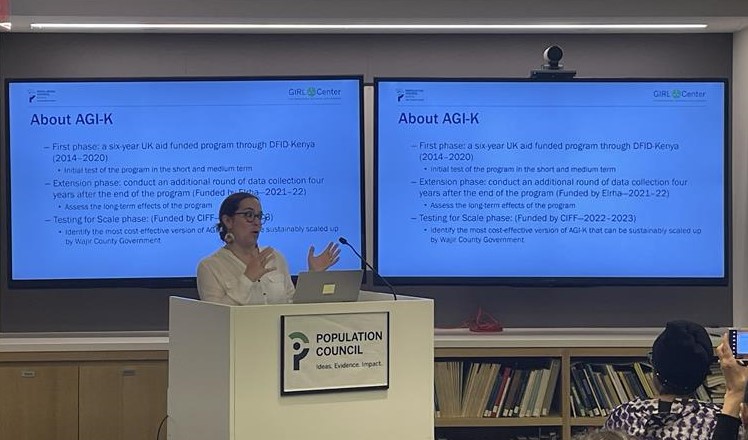
The call to invest in girls’ and women’ empowerment during the 68th session of the Commission on the Status of Women (CSW68) is timely.
While there has been notable progress toward gender equality over the past decades, globally, about 900 million girls, especially in low- and middle-income countries, remain at considerable risk. These risks include dropping out of school; being forced into early child marriages; being sexually exploited for economic gain; and being exposed to sexual and gender-based violence. Furthermore, one in 10 women live in extreme poverty. Progress toward ending poverty for girls and women needs to be 26 times faster to achieve the Sustainable Development Goals by 2030.
The girl agenda cannot wait!
The session of the Commission on the Status of Women (CSW) is hosted yearly and is the largest global gathering on gender equality and the empowerment of women and girls from the United Nations.
Accelerating Progress for Adolescent Girls
The Population Council’s GIRL Center hosted three unique events on the sidelines of CSW68 to spotlight high impact, evidence-based approaches for adolescent girls’ wellbeing, as described below.
The power of social protection for adolescent girls’ empowerment
“Social protection is a right; a right for individual adolescents’ households and communities.” —Lauren Whitehead, at the Girls Deliver Workshop held on March 13, 2024.
Over 35 participants, including government representatives, research partners, donors, and civil society, convened to underscore the power of social protection for adolescent girls’ economic empowerment. Co-hosted by the GIRL Center, UNICEF, and the Cash Transfer & Intimate Partner Violence Research Collaborative (Cash & IPV), the event highlighted best practices in implementing cash-plus programs.
Global evaluations on social protection programs for adolescent girls show several learnings.
- Social safety net programs show positive effects on adolescents’ education, sexual and reproductive health, mental health, and violence prevention.
- Social protection programs are more effective when targeted and guided by gender dynamics in various settings. Gender considerations in social protection programming should go beyond design and implementation and include evaluations with age and sex disaggregated data for better decision making.
- Integrating social protection and cash plus programs is a highly promising strategy for economic support of vulnerable households.
Learnings from Zambia focused on the Girls Education and Women Empowerment and Livelihoods Program (GEWEL), a cash-plus social protection program that reaches the most marginalized families in Zambia. Through a combined approach of social cash transfer to families and keeping girls in school through paying for their education, the program helped families to meet their household’s basic needs, and reduced incidences of pulling their children out of school due to lack of funds. The program has grown since 2017 to reach over 94,000 adolescent girls in 2023.
Similarly, the Adolescent Girls Initiative-Kenya, a multisectoral, multilevel empowerment program for adolescent girls, reached more than 6,000 girls over two years. Those girls were between the ages of 11 and 15. This occurred through layered packages that included community conversations to address inequitable gender norms, household cash transfers conditioned on girls’ school enrollment, and girls’ empowerment groups with content on health, life skills, and financial education. Girls who were out of school when the programs started were over three times more likely to go back to school by the end of the program, which over the long term led to significant delays in child marriage. The program evaluation results pointed to the importance of investing in early adolescence with multidimensional interventions for girls.
Key learnings from this program included: the need for multistakeholder approaches for effective delivery of social protection programs and having targeted, integrated interventions which cover education and economic needs for adolescent girls.

Karen Austrian speaking on AGI-K
Girls at the front and center of gender equality efforts
“Adolescent girls in all their diversity, should be recognized by stakeholders as a legitimate and distinct constituency with their unique priorities, as stated by girls, and rooted in data and evidence.” — A call to action at the Girls Deliver Workshop on March 13, 2024.
The GIRL Center, together with Women Deliver, co-hosted the Girls Deliver workshop—a convening which brought together about 35 girl-allies, to reflect on commitments made during the Women Deliver 2023 Girls Deliver Pre-conference.
The workshop focused on collective action as a key strategy for global and regional advocacy. Fifty-one organizations working with, and for, adolescent girls—from 127 countries spread across all continents—responded to an online mapping survey and provided insights to the current advocacy landscape. Key recommendations from the survey included: the need for more visibility and deliberate inclusion of the girl-agenda in global and regional advocacy moments, including CSW68, and the need for continued collaborative evidence generation on adolescent empowerment.
Multidimensional approaches to girl empowerment
“Girls cannot thrive if we focus on one aspect of their empowerment. We need to view the girl as a whole and invest in her when it counts.” — A call to action during the bilateral representatives meeting on March 14, 2024.
Co-hosted with the Government of Denmark, the GIRL Center convened a closed-door meeting with committed government stakeholders from five different countries to discuss the most effective approaches to achieve realistic, meaningful, and long-overdue change for adolescent girls.
The conversation highlighted important priorities below.
- The Population Council’s research has shown that it is important to invest in girls when they are young, between the ages of 10 and 14, before irreversible events like early and/or unintended pregnancy can anchor them in poverty.
- There are numerous gendered challenges that hinder adolescent girls’ ability to thrive and reach their full potential—from lack of access to education and healthcare to gender-based violence and early marriage. These barriers are multifaceted and complex, calling for multidimensional approaches for adolescents’ wellbeing.
- There is a need to address challenges in funding reduction due to shifting priorities when there are government transitions. This can be done through robust evidence generation which transcends multiple policy processes.
- There is a need for internal coordination among funding entities for better resource allocation to multisectoral initiatives.
The Way Forward
Adolescent girls are more vulnerable to the negative effects of unjust societies compared to other demographics. When adolescent girls are reached with comprehensive programs, including economic support to their households, they achieve better outcomes in their education and health, and better outcomes for their families and communities. Evidence shows that reaching girls earlier in adolescence sets them on a more positive life trajectory.
The events hosted by the GIRL Center on the sidelines of the commission’s convening generated tremendous energy and momentum for collaboration and progress for adolescent girls’ rights and wellbeing across sectors and geographies. Our call to the global community is to harness each other’s unique strengths and our collective power, because the girl agenda cannot wait if we are to make progress for adolescent girls and achieve the Sustainable Development Goals.
Watch “Power, Practice and Potential: Social Protection and Adolescent Girls,” co-hosted by the Population Council’s GIRL Center, UNICEF, and the Cash Transfer and IPV Research Collaborative.
